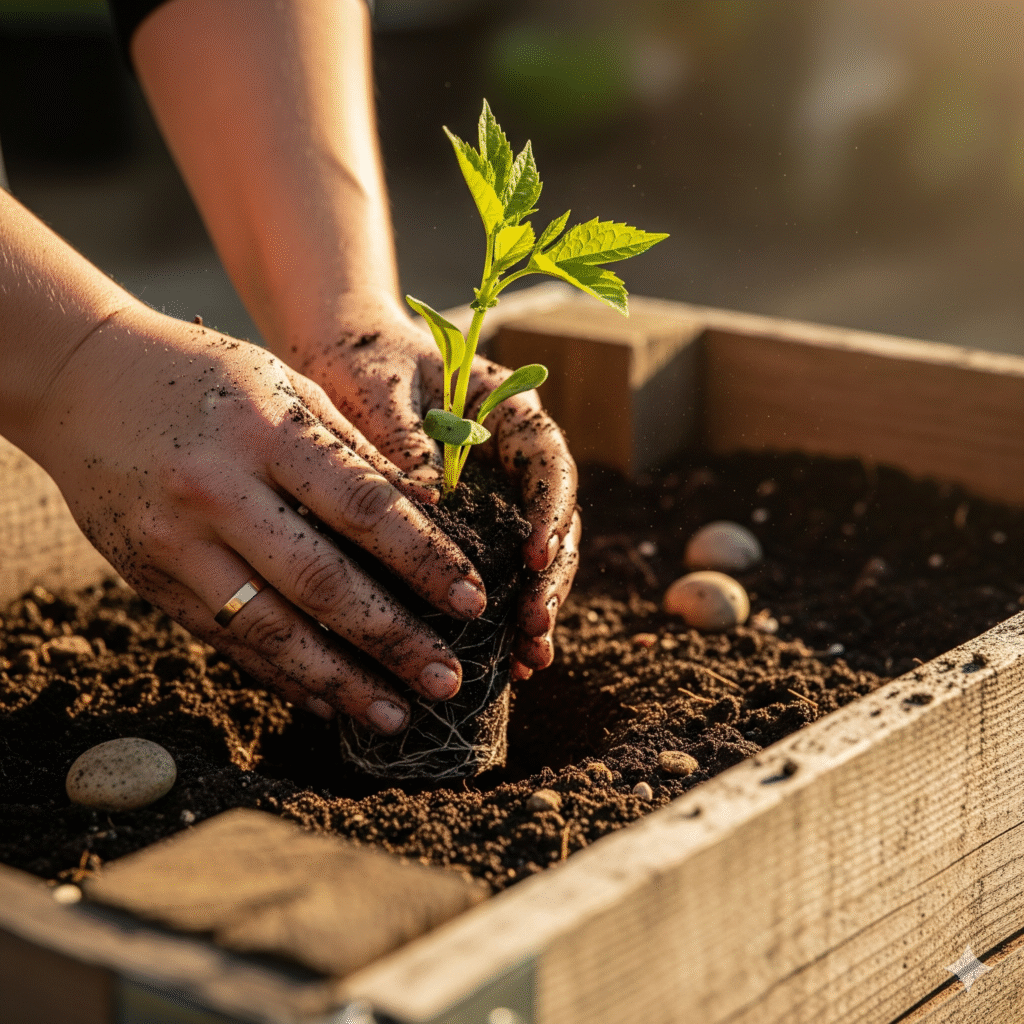Does this feel familiar? Your eyes are tired from staring at a screen. Your mind is buzzing with notifications, endless scrolling, and the low-grade anxiety of being constantly connected. You crave a way to disconnect, to do something real and tangible, but you don’t know where to start.
What if the antidote to digital burnout wasn’t an app, but a project? What if you could build a small sanctuary in your own backyard—a place to ground yourself, quiet your mind, and reconnect with the natural world?
This guide is your invitation to do just that. We’ll show you how to build raised beds sustainably, not just as a gardening project, but as the ultimate digital detox. This is about more than growing vegetables; it’s about the mindful, screen-free process of creating something beautiful with your own hands. By using sustainable, found materials, you’ll engage in a rewarding treasure hunt in the real world, turning discarded items into a foundation for new life.
Leave the phone inside. Let’s get our hands dirty and build a routine that truly nourishes.

Table of Contents
Why a Sustainable Garden is the Perfect Digital Detox
Choosing to build a garden bed is a great first step. Choosing to build it sustainably elevates the entire experience into a powerful practice of mindfulness and presence, perfectly aligned with an unplugged routine.
- Reconnect with Nature’s Rhythms: The digital world operates at the speed of light. Nature operates in seasons. Sourcing natural materials and working with the earth forces you to slow down and sync with a healthier, more patient rhythm.
- Nourish Your Mind and Body: Creating a garden free from chemical-laden materials means you’re building a truly safe space. The physical work is grounding, and the food you eventually grow will be genuinely wholesome, nourishing you from the inside out.
- Discover the Joy of Resourcefulness: Instead of the one-click purchase of a soulless kit, the sustainable path encourages a mindful hunt. The search for reclaimed wood or the perfect stones becomes a rewarding adventure, a tangible quest that replaces the empty search for digital validation.
- Create a Personal Sanctuary: This isn’t just a box of dirt; it’s a space you have crafted with intention. A garden built from materials with a story has a unique soul. It becomes your go-to spot for morning coffee, quiet reflection, and a real-world escape from digital noise.
Mindful Materials: Choosing a Sustainable Foundation
The process of choosing your materials is your first act of digital detox. It’s an invitation to look around your community, to see potential where others see waste, and to physically gather the building blocks of your sanctuary.
1. Reclaimed & Untreated Wood
This is a classic for a reason. Working with wood is a grounding, sensory experience.
- The Detox Practice: The hunt for good reclaimed wood gets you out into your community. It’s a real-world treasure hunt, talking to people and exploring places you otherwise wouldn’t.
- What to look for: Untreated pallets (“HT” stamp for heat-treated is good; “MB” stamp for chemical treatment is bad), old fence posts, wood from a demolished deck. Cedar and Redwood are excellent finds as they are naturally rot-resistant.
- Pros: Often free, feels good to give old wood new life, classic look.
- Cons: Requires careful sourcing to avoid chemically treated wood (see our safety note below).
2. Natural Logs and Branches (The Slow Method)
This method is the epitome of an unplugged routine, using the cycles of nature itself to build your garden.
- The Detox Practice: This requires strength and patience. The act of moving and placing heavy logs is a powerful, grounding physical workout that leaves no room for mental chatter. It’s a direct connection to the raw materials of the earth.
- How it works: Use large logs to form the perimeter. Over many years, this wood will slowly decompose, creating a rich, self-sustaining ecosystem right under your plants.
- Pros: Can be free, builds incredible long-term soil health, embodies the slow and patient principles of nature.
- Cons: Labor-intensive, rustic look that embraces imperfection.
3. Woven Wattle Beds (The Ancient Craft)
Tap into an ancient, mindful craft. Weaving a wattle bed is a repetitive, meditative process.
- The Detox Practice: The rhythmic in-and-out motion of weaving branches is a form of active meditation. It requires focus and presence, allowing your mind to quiet down as your hands do the work.
- How it works: Drive upright stakes into the ground, then weave flexible young branches through them to create a stunning, basket-like wall.
- Pros: 100% free, uniquely beautiful, a chance to learn a timeless skill.
- Cons: Labor-intensive; the wall will need to be rebuilt every few years, teaching a valuable lesson about impermanence.
4. Stone, Rock, and Urbanite (The Legacy Project)
Building with stone is about creating something permanent. It’s slow, deliberate work that will last for generations.
- The Detox Practice: Stacking stone is like solving a physical puzzle. Each piece must be considered and placed with care. It’s a slow, contemplative process that yields a powerful sense of accomplishment.
- What it is: Use fieldstones from your property or “urbanite”—broken pieces of old concrete—to build a wall without mortar.
- Pros: Incredibly durable, beautiful, a legacy project that connects you to a timeless building practice.
- Cons: Physically demanding; finding enough free material can take time and patience.
Crucial Safety Note: What Wood to AVOID
Part of a mindful detox is ensuring your sanctuary is truly safe. NEVER use pressure-treated wood manufactured before 2003 (often has a greenish tint) as it can contain arsenic. Similarly, avoid old railroad ties treated with creosote. Your peace of mind is paramount.
Step 1: Planning Your Unplugged Project
Before the build, take a moment to simply be in your space. This planning phase is an act of observation and intention.
- Observe the Sun: Leave your phone inside and spend a day watching how the light moves across your yard. Find the spot that gets at least 6-8 hours of sun. This practice of quiet observation is a detox in itself.
- Design for Your Body: Make your bed no wider than 4 feet, so you can reach the middle without straining. This is about creating a space that is comfortable and accessible, a place you want to be.
- Prepare the Ground Mindfully: Lay down plain cardboard to smother the grass below. As you do, set the intention for this new space. You are gently transforming this patch of ground, creating a foundation for new life without aggressive digging.
Step 2: The Mindful Build: A Step-by-Step Guide
This is where the plan becomes real. Focus on the sensory experience of the build. Put on some music, or work in silence. Be present.
Tools & Materials:
- Your chosen sustainable material (we’ll use reclaimed wood for this example)
- Tape measure, saw, drill, screws
- Your full attention
Instructions:
- Measure and Cut: Feel the weight and texture of the wood in your hands. As you measure, focus on the simple satisfaction of making a precise mark. When you cut, listen to the sound of the saw. Be right here, right now.
- Assemble the Frame: As you drill and drive the screws, notice the feeling of the tool in your hand and the satisfying way the boards come together. You are creating structure and form from discarded pieces.
- Position Your Creation: Carry the frame to its chosen spot. Place it on the cardboard foundation. Take a moment to step back and appreciate the simple, sturdy form you’ve created with your own two hands. This tangible accomplishment is a powerful antidote to the ephemeral nature of digital work.
Step 3: Building Your Soil, Building Patience
How you fill your bed is a final, beautiful lesson in the digital detox philosophy. Forget instant gratification. We’re going to build soil the slow, layered, “lasagna” way.
This method teaches the value of process and patience, reminding us that good things take time to develop.
- The Foundation (Woody Debris): Start with a base of old logs, branches, and twigs. This is the slow-release energy source for your garden, a foundation that will provide nutrients for years to come.
- The Carbon Layer (Browns): Add a thick layer of fall leaves, straw, or shredded cardboard. Think of this as the quiet, resting phase.
- The Nitrogen Layer (Greens): Add a layer of kitchen scraps, grass clippings, and coffee grounds. This is the energy, the life force that will fuel the decomposition.
- Repeat the Process: Continue layering, like you’re building a rich, complex life. Acknowledge that each element plays a crucial role.
- The Top Layer: Finish with a thick layer of compost and good soil. This is the welcoming surface where you will plant your seeds.
This bed won’t be perfect overnight. It will settle and change. The layers beneath will slowly transform into rich, black soil. Tending it is a practice in letting go of control and trusting the natural process—a vital skill in our instant-results world.
Your Unplugged Routine Awaits
You haven’t just built a garden bed. You have created a reason to step away from your screen. You have crafted a sanctuary for mindfulness, a space for quiet observation, and a source of genuine nourishment.
This project is a tangible anchor for your unplugged routine. It’s a place to go when your mind is buzzing, a reminder of the deep satisfaction that comes from patient, hands-on work. It’s proof that you can create calm and beauty in a world of digital chaos.
Ready to dive deeper without opening a single browser tab? A physical book is the perfect companion for your new unplugged hobby.
We highly recommend “The Vegetable Gardener’s Bible” by Edward C. Smith. It’s a comprehensive and beloved guide that you can bring right out into the garden with you, full of wisdom and inspiration for your new raised bed. It’s the perfect way to learn and grow, screen-free.

Are you ready to start your digital detox project? Share which part of this mindful process you’re most excited about in the comments below!